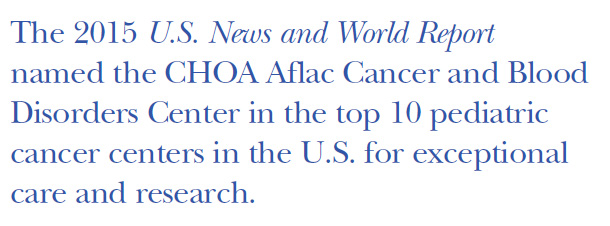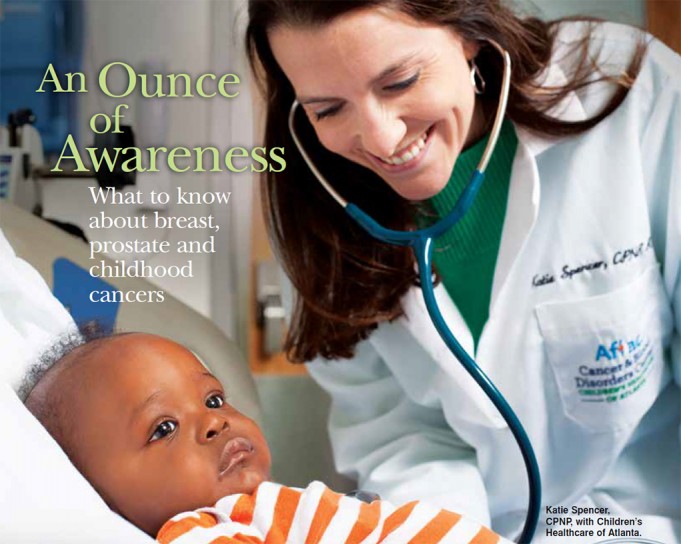What to know about breast, prostate and childhood cancers.
“Cancer” may be the one word in the English language with the ability to powerfully affect whoever hears it — the devastating disease has likely touched nearly every person in the U.S., whether it be through their own diagnosis or that of a friend or relative. Next to skin cancer, prostate cancer is the most common cancer in men, and the same is true for breast cancer in women. The American Cancer Society’s estimates for prostate cancer in the U.S. for 2015 alone include about 220,800 new cases confirmed and about 27,540 deaths. The commonality of this particular cancer can be staggering — one in seven men will be diagnosed with prostate cancer in his lifetime, with about six cases in 10 occurring in men 65 and older. With breast cancer, which affects both men and women, similar diagnoses numbers exist with 231,840 news cases of invasive breast cancer and 60,290 new cases of carcinoma in situ diagnosed in women in 2015, but with significantly more deaths: About 40,290 women will die from breast cancer this year.
“Each person is unique,” says Dr. Thomas E. Gearhard, a WellStar Health Systems family physician and member of the WellStar Board of Trustees. “Their family history is unique. Their concerns are unique. The right answer to questions of screenings and preventions are the ones that you and your physician come to after careful thought and discussion.” When it comes to awareness and prevention, studies have shown some effectiveness in lifestyle changes, but ultimately regular screenings with primary care physician remains the best defense against these diseases.
Risks and Early Detection Many factors influence breast cancer risk, and a woman can decrease her risk by maintaining a healthy weight, eating a healthy and well balanced diet, not smoking, exercising regularly, breastfeeding babies, limiting alcohol and avoiding hormone replacement therapy. “For men, there is no proven prostate cancer prevention strategy,” Gearhard says. “Studies have shown that obesity, a high fat diet from meat and dairy products, smoking and lack of exercise increases one’s risk of prostate cancer. Improvement in these areas will result in a lower risk of prostate cancer, but no lifestyle change can absolutely prevent prostate cancer.”
Gearhard says most doctors recommend men get a blood test called PSA, or prostate specific antigen, which should be started yearly at the age of 40 in high risk men, such as African-Americans and those who have a father or brother with prostate cancer, along with digital rectal exams. Average-risk men should start PSA and DRE screenings at 50. “There are not consistent recommendations from all areas of the medical community on this issue, so discussion with your physician should precede the decision to have the PSA blood test performed,” adds Gearhard.
For breast cancer, the gold standard for early detection at this time is digital mammography; recommendations vary among different medical organizations, but generally average risk women should start screening at 40 and continue with digital mammography every one to two years. High-risk women, such as those with a family history of breast cancer, should discuss the multiple options available with their physician.
When it comes to becoming educated on these cancers, Gearhard says the Internet can be a valuable tool but the wealth of misinformation or dated information can be problematic, suggesting strongly that patients seek the counsel of a trusted primary care physician to help sort through sometimes conflicting information. “I find that the best time to discuss cancer screening is at the time of a person’s annual physical exam,” he says. “With the advent of the Affordable Care Act and the mandate to provide preventative screenings, I see more and more of my patients for their preventative exam.”
Raising Awareness About Childhood Cancer
“While survival rates for many childhood cancers are increasing, we still have a lot of work to do to find a cure. Everyone should join the fight against childhood cancer, whether it’s by raising awareness or donating to research,” says Dr. William G. Woods, director of the Aflac Cancer and Blood Disorders Center of Children’s Healthcare of Atlanta. He says childhood cancers are more common than people realize, and remain as rampant as ever — in nearly 20 years, the number of diagnosed annual cases has not gone down and every day in the U.S., 43 children are diagnosed with some form of cancer, according to CureSearch. The average age of children diagnosed is 6.
Though early warning signs vary, Woods says parents should be aware and see a healthcare professional if their child experiences unexplained weight loss; headaches; swelling or lumps; excessive bruising, bleeding or rashes; nausea; tiredness; or frequent infections or fevers. As only 2 percent of federal funding goes to childhood cancer research, donations are of vital importance to research for a cure. In the past 20 years, only two new drugs have been developed specifically for children’s cancers, compared to the more than 50 for adults in the past five years alone. Currently, CHOA treats more than 98 percent of children with cancer in all of metro Atlanta, specializing in the most common forms to the rarest cancers only seen in top centers.

Through research, CHOA has taken the cure rate in childhood cancer from 25 percent in the 1960s to 80 percent today. The 2015 U.S. News and World Report named the Aflac Cancer and Blood Disorders Center in the top 10 pediatric cancer centers in the U.S. for exceptional care and research. “Children’s remains tirelessly dedicated to providing a brighter future for children and young adults with cancer and blood disorders,” says Woods. “We have expanded Aflac Cancer Center services at each of our three hospital campuses — Egleston, Scottish Rite and Hughes Spalding — where lifesaving treatment takes place every day. We also participate in awareness events and campaigns throughout the year, with a specific focus on September, which is National Childhood Cancer Awareness Month.”
To help raise awareness, CHOA created a special website (choa.org/fightcancer) with important information, surprising facts about childhood cancer and ways to get involved in the fight against this terrible disease. “More than 15,000 children and adolescents aged 0 to 19 years are diagnosed with cancer annually in the U.S.,” Woods explains. “Approximately one in 285 children in the country will be diagnosed with cancer before their 20th birthday. At the Aflac Cancer Center, we treat over 400 new patients every year.”
In the fight against cancer, awareness is key — be sure to seek the counsel of a healthcare professional you trust to monitor risk factors in your own life. To support the efforts of National Childhood Cancer Awareness Month, you can visit the Children’s Cancer Research Fund (childrenscancer.org). Also in September is National Prostate Cancer Awareness Month, followed by Breast Cancer Awareness Month in October; to get involved and support funding a cure for these diseases, visit the American Cancer Society at cancer.org.
—————
Post-cancer and Physical Therapy For Dr. Gregory Dean, owner of Achieve Physical Therapy Solutions in Marietta, participation in physical and occupational therapy services post-cancer treatment is an important component on a cancer survivor’s path to recovery. “We help to restore those functional deficits that may otherwise limit each patient’s recovery, with the goal of returning each individual to their prior level of function,” says Dean. Physical therapy services are an important means of addressing common musculoskeletal and neuromuscular disorders and other common disorders that can limit a person’s functional abilities.
Physical therapists are board-certified, state-licensed healthcare practitioners who work as part of a patient’s healthcare team to educate and help improve their ability to assimilate into more normal capacity. “It is imperative to implement a comprehensive rehabilitation program for individuals and their family members who have recently participated in a post-cancer treatment program,” Dean says. “Oncologists are recognizing the importance and benefits of rehabilitation post treatment to help address pain, oss of strength and endurance, any residual swelling of the limbs and to restore any mechanical deficits that may have been potential side effects of their treatment.”
As part of a cancer survivor’s healthcare team, both occupational and physical therapists employ a myriad of methodologies, including manual therapy, flexibility and strengthening exercises, cardiovascular and endurance exercises, patient and family education, non-contraindicated modalities and ergonomic assessments for home and work when needed to work force reintegration.
“Post-cancer physical and occupational therapy care is largely dependent on the type of cancer diagnosed,” Dean explains. “At Achieve Physical Therapy, we look at the deficits of each patient and the patient and family’s goals in order to prevent a cookie-cutter approach to care. We perform a comprehensive evaluation to assess the cancer survivor’s deficits and develop a personalized plan of care with a holistic approach for recovery.” Deficits of this nature may include weight changes, neuropathy of extremities, pain, decreased strength, generalized deconditioning/fatigue and swelling of the extremities, known as lymphedema.















